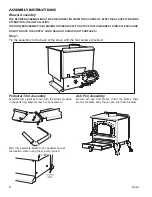
12
Fig. 5 -
Gas Regulator Location and Gas Line
Access Into Stove Cabinet
Fig. 6 -
External Regulator With Vent Pointing Down
CONNECTING TO GAS SUPPLY
WARNING
: A qualified technician must connect heater to gas supply. Follow all local
codes.
WARNING
: This appliance requires a 3/8 in. NPT inlet connection to pressure regulator
(see Fig. 5).
CAUTION
: Never connect heater directly to the gas supply. This heater requires an external
regulator (not supplied). The external regulator between the gas supply and heater must be
installed. Gas supplier provides external regulator for natural gas.
INSTALLATION ITEMS NEEDED
Before installing heater, make sure you have the items listed below.
• piping (check local codes) sealant
• (resistant to propane/LP gas)
• equipment shutoff valve*
• test gauge connection**
• sediment trap
• tee joint
• pipe wrench
• flexible gas hose (check local code)
A CSA design-certified equipment shutoff valve with 1/8 in. NPT tap is an acceptable alternative
to test gauge connection. Purchase the optional CSA design certified equipment shutoff valve
from your dealer.
WARNING
: Never connect heater to private (non-utility) gas wells. This gas is commonly
known as wellhead gas.
The installer must supply an external regulator for liquid propane. The external regulator is
provided by the gas supplier for natural gas. The external regulator will reduce incoming
gas pressure. You must reduce incoming gas pressure to between 11 and 14 in. of
water column for propane and between 5 and 10.5 in. of water column for natural gas.
If you do not reduce incoming gas pressure, heater regulator damage could occur. Install
external regulator with the vent pointing down as shown in Fig. 6. Pointing the vent
down protects it from freezing rain or sleet.
Propane/LP
Supply Tank
External
Regulator
Propane/LP
Supply Tank
Vent Pointing Down
Gas regulator
Inlet connector
Summary of Contents for CRHSD25RT
Page 33: ...33 ...













































